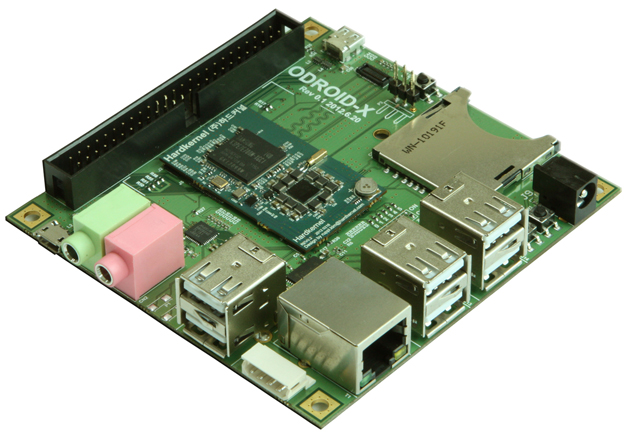ODROID-X: The $129 Quad-core Alternative to Raspberry Pi
Raspberry Pi better watch out, there's a new compact solution in town.
Raspberry Pi has been hugely popular since launch, but the little board doesn't pack a big punch. What to do if you're looking for something more powerful? Korean company Hardkernel has a quad-core solution that might be suitable. Dubbed ODROID-X, the developer board measures 3.5 x 3.7 inches and packs a a 1.4 GHz Exynos 4412 quad-core ARM Cortex-A9 CPU, Mali 400 graphics, 1GB of RAM, 6 USB 2.0 ports, 10/1000Mbps Ethernet, mic and headphone jacks, a full-sized SDHC card slot, and runs on Google's Android 4.0.4. You can also opt for some additional features including a WiFi chip and antenna, LCD, Bluetooth, HDMI, camera, and storage modules.
Obviously, this is a huge step up from Raspberry Pi's ARM1176JZF-S700 MHz CPU, VideoCore IV GPU, and 256 megabytes of RAM, and this jump in spec also applies to the price. While a Raspberry Pi board will only set you back $35, the ODROID-X costs significantly more at $129. Still, this is a device aimed at software and hardware developers and enthusiasts, whereas Raspberry Pi was designed to be used in the classroom to teach the basics of computer science. Perhaps kids starting out with Raspberry Pi will want to graduate to the ODROID-X before long.
ODROID-X is available now via Hardkernel's website.
Follow @JaneMcEntegart on Twitter.
Get Tom's Hardware's best news and in-depth reviews, straight to your inbox.

Jane McEntegart is a writer, editor, and marketing communications professional with 17 years of experience in the technology industry. She has written about a wide range of technology topics, including smartphones, tablets, and game consoles. Her articles have been published in Tom's Guide, Tom's Hardware, MobileSyrup, and Edge Up.
-
Kami3k With a name like ODROID-X there isn't many Android phones that they didn't try to merge together....Reply -
asnorton44 tomsreaderHDMI?"You can also opt for some additional features including a WiFi chip and antenna, LCD, Bluetooth, HDMI, camera, and storage modules."Reply -
blader15sk8 tomsreaderHDMI?According to the website it uses Micro HDMI, which is either the connection at the very top of the pic, or the one next to the audio connectors.Reply -
joytech22 I think the GPU on the RPi is more powerful than the Mali400 on this.Reply
Considering the RPi GPU is more powerful than the 4S GPU, which in turn is more powerful than the SGS2's Quad-core Mali-400 GPU. -
alidan id like it if it was cheaper, i mean a tegra 3 console is being made, gives you a controller for 99$Reply -
Camikazi MauveCloudIs that a 50-pin SCSI port along the upper left side?Looks like an expansion port to me.Reply
